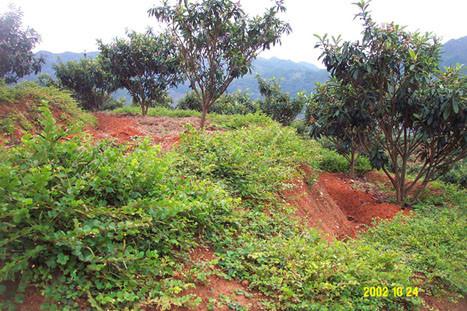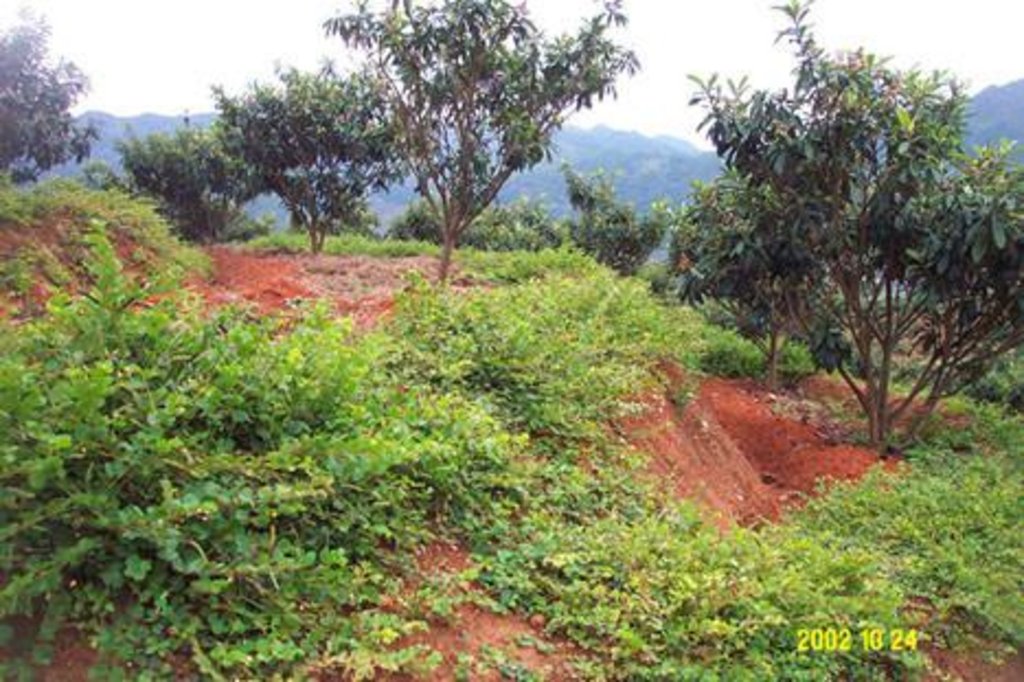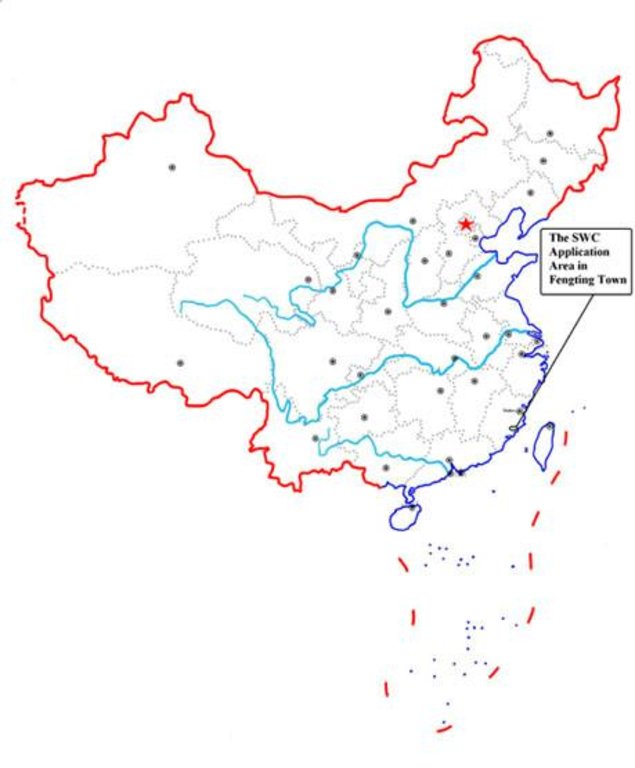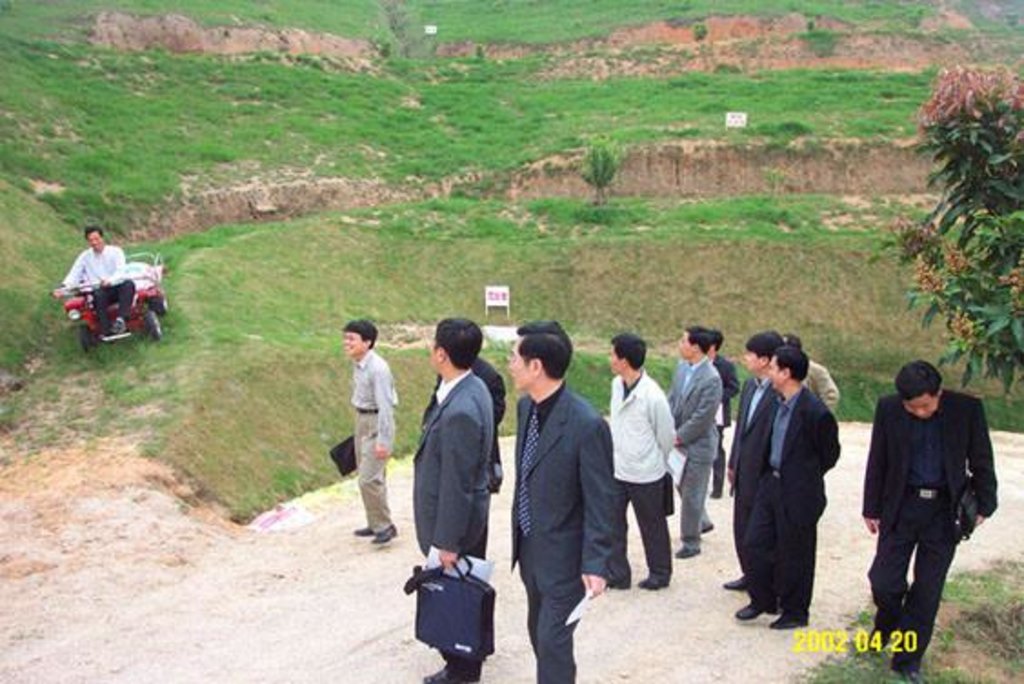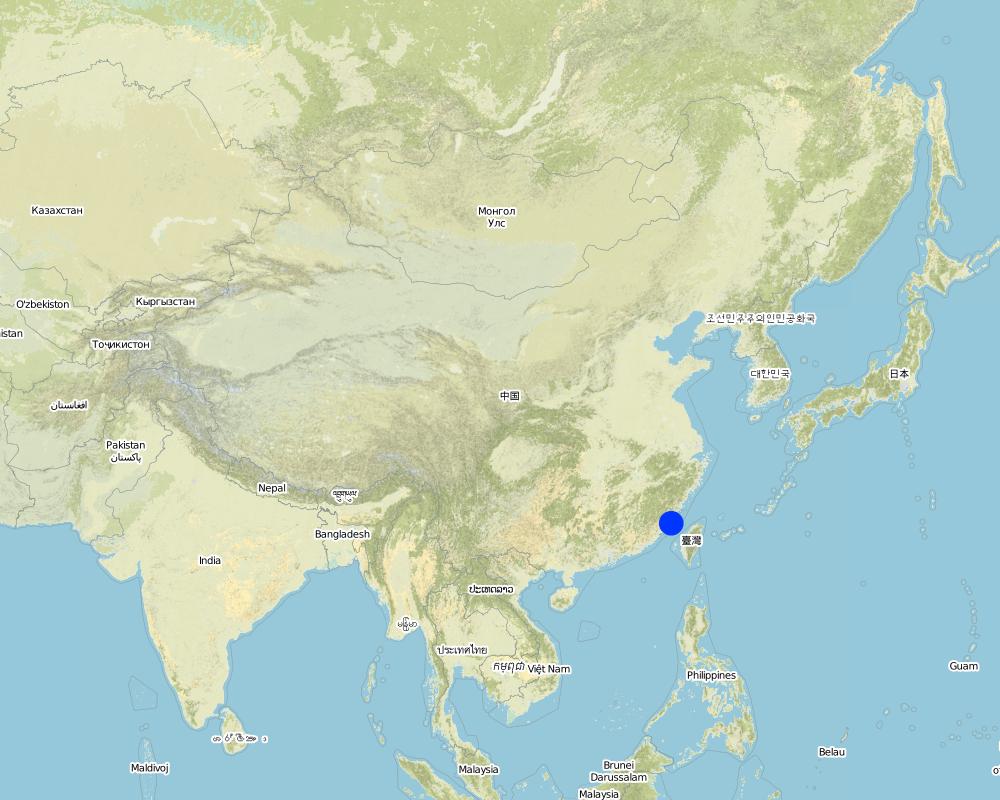Front Bank, Back Ditch on Contour Terraces [中国]
- 创建:
- 更新:
- 编制者: Unknown User
- 编辑者: –
- 审查者: Laura Ebneter
approaches_2406 - 中国
查看章节
全部展开 全部收起1. 一般信息
1.2 参与方法评估和文件编制的资源人员和机构的联系方式
关键资源人员
SLM专业人员:
Lin Wengian
Soil & Water Conservation Office of Putian
No. 13 Canghou Road, Chengnei District of Putian City, 351100, Putian, Fujian
中国
有助于对方法进行记录/评估的机构名称(如相关)
Soil & Water Conservation Office of Putian - 中国1.3 关于使用通过WOCAT记录的数据的条件
编制者和关键资源人员接受有关使用通过WOCAT记录数据的条件。:
是
1.4 SLM技术问卷的参考
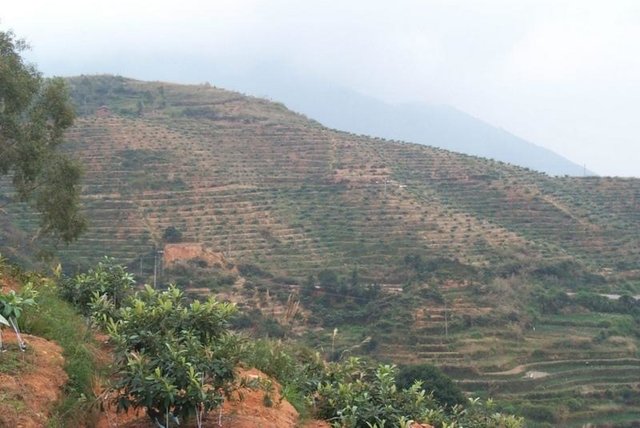
Orchard Rehabilitation [中国]
Contour terrace protection with front bank and three ditches in orchard rehabilitation.
- 编制者: Unknown User
2. SLM方法的描述
2.1 该方法的简要说明
Using contour principle, constructing terraces with the front bank and back ditch in order to control soil & water erosion.
2.2 该方法的详细说明
该方法的详细说明:
In the area with sufficient rainfall, overflow and runoff often destroy the existing terraces causing much cost for maintaining. Sluice system of terraces is important when building a terrace. The technology of the Front Bank and Back Ditch on Terrace is to solve this problem. The approach is that building front bank on a terrace edge and digging a ditch on the back terrace as well as digging a ditch upright the terrace along a relatively low rill to induct overflow out.
2.3 该方法的照片
2.5 采用该方法的国家/地区/地点
国家:
中国
区域/州/省:
Fujian
Map
×2.6 该方法的开始和终止日期
注明开始年份:
1991
终止年份(若不再采用该方法):
1996
2.7 方法的类型
- 基于项目/方案
2.8 该方法的主要目的/目标
Controlling the soil erosion and raising farmers' consciousness of soil conservation.
The SLM Approach addressed the following problems: The poor quality of fruit trees and seedlings and Disafforestation of the natural vegetation by the man-made factors resulted in the soil erosion and low agricultural production and hindered the local socio-economic development. In addition, the local farmers lack fund.
2.9 推动或妨碍实施本办法所适用的技术的条件
财务资源和服务的可用性/可得性
- 阻碍
Lack of fund
Treatment through the SLM Approach: Raising fund and obtain subsidy from government.
法律框架(土地使用权、土地和水使用权)
- 启动
The existing land ownership, land use rights / water rights moderately helped the approach implementation: Separation between ownership and usufruct of land, to some extent, enhances the land users' enthusiasm of SWC investment.
了解SLM,获得技术支持
- 阻碍
Enhancing training propaganda of SWC technology to farmers.
3. 相关利益相关者的参与和角色
3.1 该方法涉及的利益相关者及其职责
- 当地土地使用者/当地社区
working land users were work equally divided between men and women (Among the farmers and the soil conservation agencies.)
taking in charge of the program
- SLM专家/农业顾问
- 地方政府
assisting the programe design, soil conservation institute
3.2 当地土地使用者/当地社区参与该方法的不同阶段
| 当地土地使用者/当地社区的参与 | 指定参与人员并描述活动 | |
|---|---|---|
| 启动/动机 | 外部支持 | |
| 计划 | 无 | |
| 实施 | 无 | responsibility for major steps |
| 监测/评估 | 自我动员 | interviews/questionnaires; |
| Research | 互动 |
3.4 有关SLM技术选择的决策
具体说明谁有权决定选择要实施的技术:
- 主要是SLM专家,咨询土地使用者之后
解释:
Decisions on the method of implementing the SLM Technology were made by mainly by SLM specialists with consultation of land users.
4. 技术支持、能力建设和知识管理
4.1 能力建设/培训
是否为土地使用者/其他利益相关者提供培训?:
是
明确受训人员:
- 土地使用者
- SWC specialists, Planners(3)
培训形式:
- 示范区域
- 课程
培训形式:
- farm visits
涵盖的主题:
Teaching them how to control pests and diseases and new techniques on management of orchards.
4.2 咨询服务
土地使用者有权使用咨询服务吗?:
是
说明/注释:
Name of method used for advisory service: Soil Conservation in Orchard; Key elements: Setup a demonstration area, field visit, organizing; 1) Mainly: projects own extension structure and agents, Partly: government's existing extension system 2) Mainly: projects own extension structure and agents, Partly: government's existing extension system; Extension staff: Mainly government employees 3) Target groups for extension: Land users, SWC specialists; Activities: demonstration of the field; extend the techniques.
4.3 机构强化(组织发展)
是否通过这种方法建立或加强了机构?:
- 是,适度
具体说明机构的强化或建立程度:
- 本地
具体说明支持类型:
- 能力建设/培训
4.4 监测和评估
监测和评估是该方法的一部分吗?:
是
注释:
technical aspects were regular monitored through measurements
socio-cultural aspects were ad hoc monitored by through observations
economic / production aspects were ad hoc monitored through measurements
area treated aspects were regular monitored through measurements
land users involved aspects were ad hoc monitored through measurements
management of Approach aspects were ad hoc monitored through observations
There were few changes in the Approach as a result of monitoring and evaluation: Through in situ observation and demonstration
4.5 研究
研究是该方法的一部分吗?
是
明确话题:
- 技术
提供进一步的细节,并指出是谁做的研究:
Studying on engineering and vegetative measures. Research was carried out both on station and on-farm
5. 融资和外部物质支持
5.1 该方法中SLM组成部分的年度预算
如果不知道准确的年度预算,请给出一个范围:
- 100,000-1,000,000
注释(例如主要的资助来源/主要捐助者):
Approach costs were met by the following donors: international: 30.0%; national non-government: 15.0%; local community / land user(s): 55.0%
5.2 为土地使用者提供财政/物质支援
土地使用者是否获得实施该技术的财政/物质支持?:
是
5.3 对特定投入的补贴(包括劳动力)
- 设备
| 具体说明哪些投入得到了补贴 | 程度如何 | 对补贴做出具体说明 |
|---|---|---|
| 机械 | ||
| 工具 | ||
- 农业
| 具体说明哪些投入得到了补贴 | 程度如何 | 对补贴做出具体说明 |
|---|---|---|
| 种子 | seedlings | |
- 基建
| 具体说明哪些投入得到了补贴 | 程度如何 | 对补贴做出具体说明 |
|---|---|---|
| community infrastructure | ||
如果土地使用者的劳动力是一项重要的投入,那么是不是:
- 自愿
注释:
and paid in cash
5.4 信用
是否根据SLM活动的方法给予信用值?:
否
6. 影响分析和结论性陈述
6.1 方法的影响
该方法是否帮助土地使用者实施和维护SLM技术?:
- 否
- 是,很少
- 是,中等
- 是,支持力度很大
They apply much more organic fertilizers to improve the soil fertility.
该方法是否改善了阻碍SLM技术实施的土地使用权/用户权问题?:
- 否
- 是,很少
- 是,中等
- 是,支持力度很大
The land use right can help the land users to better develop and manage their lands after signing land use right contract. The problem is likely to be overcome in the near future. Well organizing work can overcome it.
Did other land users / projects adopt the Approach?
- 否
- 是,很少
- 是,中等
- 是,支持力度很大
6.3 方法活动的可持续性
土地使用者能否维持通过该方法实施的措施(无外部支持的情况下)?:
- 是
6.4 该方法的长处/优点
| 土地使用者眼中的长处/优势/机会 |
|---|
| Increasing yield (fruit trees and crops), and income. (How to sustain/ enhance this strength: introducing new species in.) |
| 编制者或其他关键资源人员认为的长处/优势/机会 |
|---|
| Harvesting or inducing excrescent rainfall and runoff. (How to sustain/ enhance this strength: Maintaining timely) |
| Making fully use of the mountain and hilly areas with SWC and developing local economy. (How to sustain/ enhance this strength: Introducing new species in.) |
6.5 该方法的弱点/缺点以及克服它们的方法
| 土地使用者认为的弱点/缺点/风险 | 如何克服它们? |
|---|---|
| Cost much and liitle fund available. | Raising money and trying to use mechanic tools in stead of manual labor. |
| 编制者或其他关键资源人员认为的弱点/缺点/风险 | 如何克服它们? |
|---|---|
| Cost much for the construction. | subsidy from government, and planting cash crops and fruit trees etc. to increase the return. |
7. 参考和链接
7.1 方法/信息来源
- 实地考察、实地调查
- 与土地使用者的访谈
链接和模块
全部展开 全部收起链接

Orchard Rehabilitation [中国]
Contour terrace protection with front bank and three ditches in orchard rehabilitation.
- 编制者: Unknown User
模块
无模块


